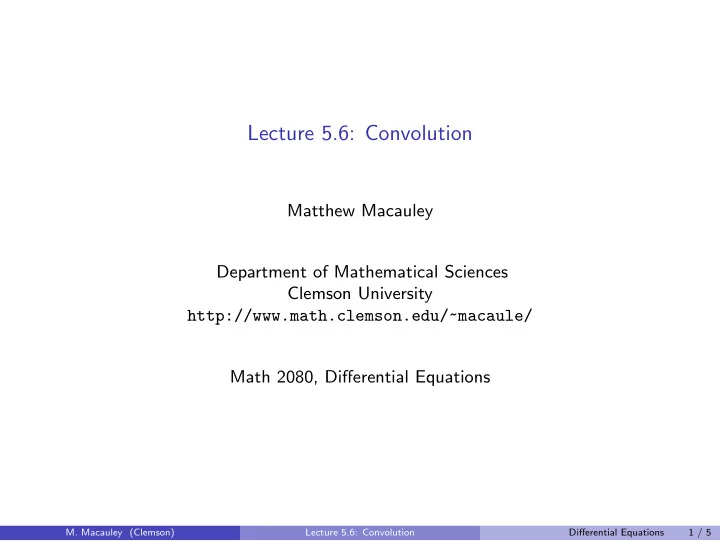

Lecture 5.6: Convolution Matthew Macauley Department of Mathematical Sciences Clemson University http://www.math.clemson.edu/~macaule/ Math 2080, Differential Equations M. Macauley (Clemson) Lecture 5.6: Convolution Differential Equations 1 / 5
Introduction Motivation Laplace transforms are hard to compute. We like formulas that allow us to compute new ones from old. For example, L{ e ct f ( t ) } = F ( s − c ) , L{ f ( t ) + g ( t ) } = F ( s ) + G ( s ) . Question : Is there a formula for L{ f ( t ) g ( t ) } ? Next best thing There is a multiplicative formula for the inverse Laplace transform: � t L − 1 { F ( s ) G ( s ) } = f ( t ) ∗ g ( t ) := f ( u ) g ( t − u ) du . 0 M. Macauley (Clemson) Lecture 5.6: Convolution Differential Equations 2 / 5
Practice with convolution Definition � The convolution of f ( t ) and g ( t ) is the function ( f ∗ g )( t ) := f ( u ) g ( t − u ) du . R Properties f ∗ g = g ∗ f ; f ∗ ( g ∗ h ) = ( f ∗ g ) ∗ h . Examples 1. Compute t 2 ∗ t = 2. Compute f ( t ) ∗ 1 = M. Macauley (Clemson) Lecture 5.6: Convolution Differential Equations 3 / 5
Convolutions unrelated to Laplace transforms Example Suppose a company dumps radioactive waste at a rate f ( t ) that decays exponentially with rate constant k . Determine how much waste remains at time t . M. Macauley (Clemson) Lecture 5.6: Convolution Differential Equations 4 / 5
Back to (inverse) Laplace transforms Theorem If L{ f ( t ) } = F ( s ) and L{ g ( t ) } = G ( s ), then � t L − 1 { F ( s ) G ( s ) } = f ( t ) ∗ g ( t ) = f ( u ) g ( t − u ) du . 0 M. Macauley (Clemson) Lecture 5.6: Convolution Differential Equations 5 / 5
Recommend
More recommend